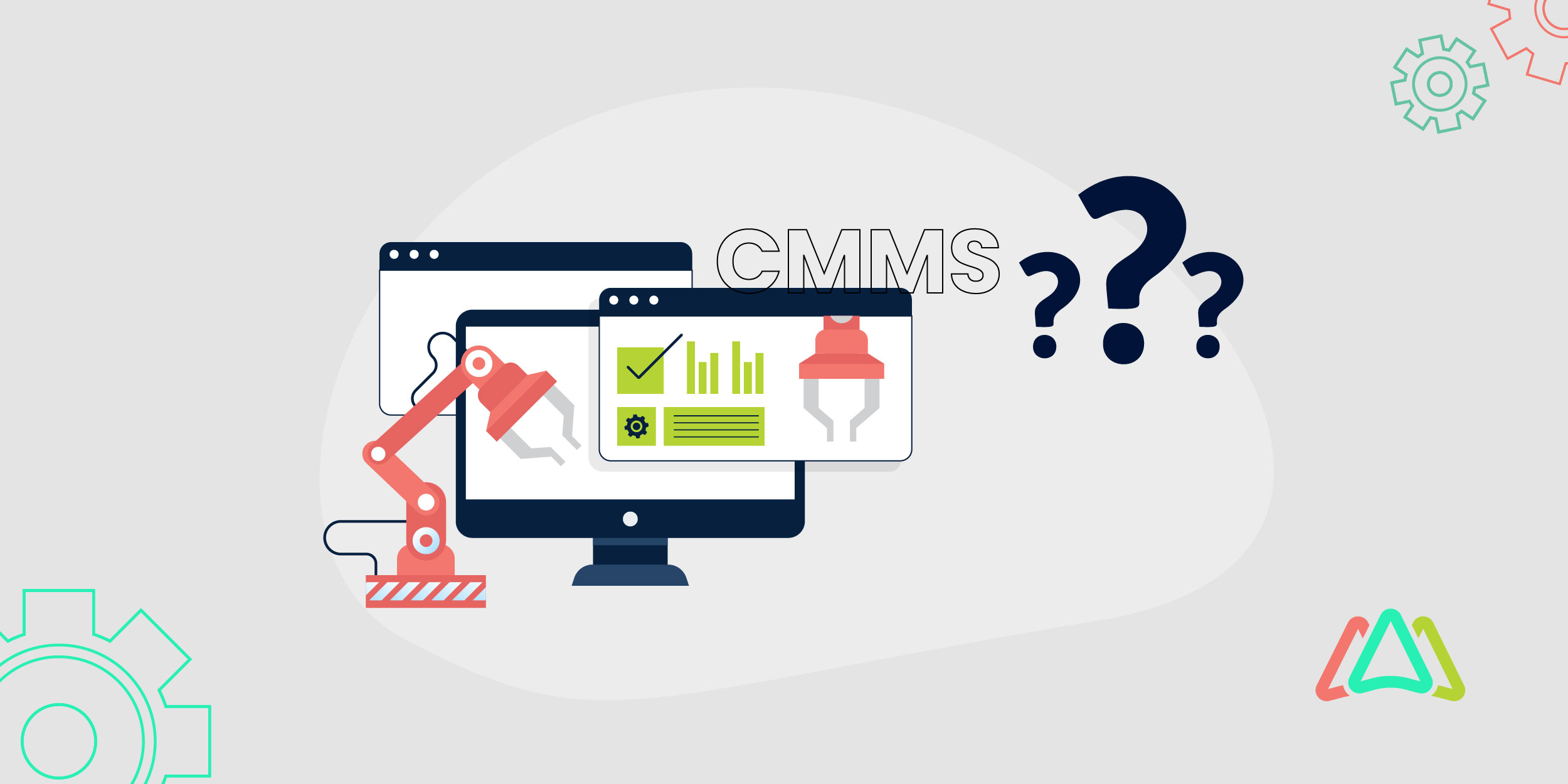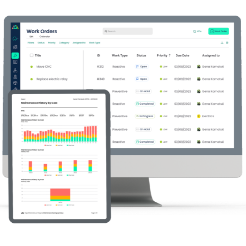
CMMS … What’s the Big Fuss All About?
CMMS stands for Computerized Maintenance Management System. CMMS system is a software system that helps organizations manage and track their maintenance activities for various equipment, machinery, and other assets.
CMMS software includes features such as work order management, preventive maintenance scheduling, inspections, inventory management, asset tracking, and reporting. It allows maintenance departments to organize and prioritize their work, track equipment performance, and ensure that maintenance activities are completed on time and efficiently.
Maintenance management software can be used in a variety of industries such as manufacturing, healthcare, hospitality, education, transportation, and facilities management. CMMS software helps businesses reduce equipment downtime, extend the life of their assets, reduce costs, and increase productivity and profitability.
Overall, a CMMS is an effective tool for maintenance management, empowering organizations to streamline their maintenance operations and ensure that their assets are performing at their best.
The CMMS system - A historical view
CMMS systems first appeared in the 1960s when mainframe computers were used to manage maintenance operations in manufacturing plants. With the emergence of personal computers in the 1980s, CMMS became more accessible to a broader range of businesses. Today, cloud-based CMMS solutions are widely available and are used in almost all industries that have a need to track and maintain critical equipment including but not limited to municipalities, religious institutions, restaurants and retail, construction and agriculture, education, hotels and casinos, sports facilities, and offices. They have become more accessible to these industries due to lower costs and less complex implementation requirements, making it easier for small and medium-sized businesses to implement them.
Increased demand for CMMS systems
The demand for CMMS software has grown steadily over the past 20 years and is expected to continue growing into the future. This growth is the result of several factors, including businesses' focus on asset optimization, increased automation, and the need to find more efficient and cost-effective ways to manage their maintenance operations.
Over the past decade, we’ve seen the global CMMS market grow significantly, with the market size expected to reach USD 2.2 billion by 2028, according to a report by Grand View Research. Reasons for this growth include the need for improved maintenance efficiency, the rising adoption of predictive maintenance, and the increasing use of IoT devices to collect data on equipment performance.
One of the main drivers for the increased demand for CMMS solutions is the shift towards automation and Industry 4.0. As businesses increasingly automate their operations, the need for effective maintenance and asset management becomes more important. CMMS solutions provide a centralized system for managing maintenance activities, scheduling maintenance tasks and work orders, and tracking asset performance. The software ultimately makes it easier for organizations to maintain their key assets and facilities.
Another key factor driving the demand for CMMS software is the focus on asset optimization. As businesses seek to maximize the lifespan and performance of their assets, they need to implement effective maintenance strategies. A CMMS enables businesses to track asset performance, identify maintenance needs, and schedule maintenance tasks, ensuring that assets are well-maintained and operating at peak performance.
As businesses increasingly prioritize maintenance efficiency, asset optimization, and automation, we can expect the demand for CMMS software to grow in the coming years. As technology continues to evolve, we should expect to see even more innovations in the CMMS space, with new features and capabilities that enable businesses to improve their maintenance processes and optimize their assets. In the last 10 years we have seen a shift from on-premise to cloud deployments, desktop to mobile devices, the use of IoT sensors for predictive maintenance, and now the introduction of artificial intelligence (A.I.) into CMMS solutions.
Key benefits of CMMS software
There are several key benefits of a CMMS driving businesses from a variety of industries to invest in them. The following are 4 key benefits.
1. Improved maintenance efficiency
A CMMS helps businesses streamline maintenance processes, reduce paperwork, and automate maintenance tasks. This leads to improved efficiency in maintenance operations, as maintenance technicians can focus on performing work that adds value and spend less time on unnecessary paperwork and other non essential tasks.
2. Reduced equipment downtime
With a maintenance management software system, businesses can schedule and stay on top of preventative maintenance tasks. By having an automated preventive maintenance plan in place, companies reduce the likelihood of equipment breakdowns and downtime. This helps to keep equipment running at optimal levels and minimizes disruptions to operations. In addition, planned maintenance is a lot less expensive when compared to reactive maintenance. Downtime is also very expensive depending on the type of equipment. Nonetheless, if machines are down and not operational, customers are not being served which negatively impacts the business.
3. Improved asset management
A CMMS ensures companies can keep track of equipment and inventory, providing real-time visibility into equipment status and maintenance requirements. This real-time visibility allows businesses to optimize the ways they manage their assets, extend the lifespan of equipment, and reduce the risk of equipment failure.
4. Better decision-making based on data and analytics
CMMS software provides managers with real-time data on maintenance activities and equipment performance. In order to make effective decisions on how to allocate resources, maintenance and facilities managers need to have access to reliable and accurate data. CMMS software provides managers with data on metrics like mean time to repair, mean time between failure, planned maintenance percentage, equipment downtime and more. With a CMMS, maintenance managers can pull reports on maintenance history on any asset being tracked with a couple of clicks. This kind of data is imperative for managers to identify trends, optimize maintenance schedules, and make data-driven decisions to improve maintenance operations.
More businesses today are investing in CMMS software to achieve these benefits. By implementing a CMMS, organizations improve maintenance operations, reduce costs, and increase efficiency. The more assets and equipment a business uses in its operations, the more value they can derive from a maintenance management solution. CMMSs are also important to companies faced with regulatory compliance requirements.
Recent trends in CMMS
Believe it or not, the growing demand for maintenance management software has resulted in a competitive market made up of hundreds of solutions to choose from. According to Capterra, there are over 400 software products under its CMMS category. With so many products in the market, we see several trends emerging in these products as they try to differentiate themselves. Some of these notable trends are as follows:
1. Focus on user experience
Many CMMS solutions are focusing on improving the user experience, making the software more intuitive and user-friendly. This helps to improve adoption rates and ensures that users can make the most of the software's capabilities. Historically, CMMS software had its challenges with being implemented successfully. This was largely due to the complexity of the software and end-users not being tech-savvy. In the past, user adoption was low and companies did not realize the ROI they expected. CMMS providers have taken note and today we are seeing more solutions entering the market that are easy to use and set up. This results in faster ROI and a better user experience.
2. Shift to cloud-based solutions
More businesses today are opting into cloud-based CMMS solutions over on-premise deployments. Cloud-based solutions are seen as offering greater accessibility, scalability, and affordability. They are also much easier to update and maintain as the updates and maintenance demands shift to the provider from the buyer’s internal IT department. Security and compliance has also improved significantly over the past few years with cloud deployments.
While some businesses may still prefer on-premise solutions due to specific security or control requirements, the overall trend is towards cloud-based solutions. This is likely to continue in the future, as businesses increasingly prioritize accessibility, scalability, and affordability in their software solutions.
3. Mobile accessibility
Most, if not all CMMS solutions now offer mobile accessibility, allowing maintenance technicians and managers to access and update data anywhere. This improves the accessibility of CMMS data and streamlines communication between technicians and managers. Just imagine the time is saved when you compare the steps required to create and update work orders from paper and pen, or using a desktop computer, compared to using a mobile device. The larger the team (technicians and managers), the more efficiencies gained and time and money saved.
4. Integration with other key business software
CMMS solutions are increasingly being integrated with other business software systems, such as Enterprise Resource Planning (ERP), Customer Relationship Management (CRM) systems, and accounting and HR systems. This allows businesses to have a more holistic view of operations, cleaner data, reduce time spent on double entry and make data-driven decisions. CMMS systems today allow users to connect to key business applications through an API or direct pre-built connectors.
5. Advanced analytics and AI
 CMMS solutions are incorporating advanced analytics and Artificial Intelligence (AI) capabilities to improve predictive maintenance. By analyzing data on equipment performance, a CMMS can identify patterns and predict when maintenance is needed, allowing businesses to schedule maintenance proactively. AI has just begun to unfold and the future is looking promising. Not only will it enable managers to get predictive analytics, but also reduce the time for redundant data entry.
CMMS solutions are incorporating advanced analytics and Artificial Intelligence (AI) capabilities to improve predictive maintenance. By analyzing data on equipment performance, a CMMS can identify patterns and predict when maintenance is needed, allowing businesses to schedule maintenance proactively. AI has just begun to unfold and the future is looking promising. Not only will it enable managers to get predictive analytics, but also reduce the time for redundant data entry.
These trends demonstrate a growing focus on improving the accessibility, integrations, usability, and value of CMMS solutions for businesses. As technology continues to evolve, we can certainly expect to see greater innovations and enhancements in the CMMS space.
TABLE OF CONTENTS
Keep Reading
Spare parts management within maintenance can make the difference between a problem-free ...
16 Dec 2025
Every maintenance team eventually faces the same question: When should we repair, and when ...
12 Dec 2025
Enterprise Asset Management (EAM) software has become a cornerstone for organizations aiming ...
12 Dec 2025
Unexpected equipment breakdowns can disrupt operations, increase repair costs, and reduce ...
11 Dec 2025
Businesses are always looking for ways to improve efficiencies, reduce costs, and improve ...
9 Dec 2025
The longest U.S. federal government shutdown to date lasted 43 days, beginning on October 1, ...
5 Dec 2025
Every maintenance professional faces it sooner or later — that critical time when an aging ...
18 Nov 2025
The term 'best' is often used loosely, without a clear understanding of its context or ...
14 Nov 2025
In the not too distant past, maintenance strategies have been defined by reaction—fixing ...
13 Nov 2025
Tax season is the time of year that often sends a ripple of anxiety through many of us. The ...
11 Nov 2025
Selecting a Computerized Maintenance Management System (CMMS) can, at first glance, be an ...
4 Nov 2025
In healthcare facilities, equipment uptime involves more than achieving operational ...
31 Oct 2025
Companies are subject to economic ups and downs, also known as economic volatility. Today, ...
30 Oct 2025
Maintenance challenges are a constant struggle, with unplanned downtime costing manufacturers ...
27 Oct 2025
Last winter, a maintenance technician at a U.S. paper mill ignored a predictive alert that ...
10 Oct 2025
Many organizations proudly say they “have a CMMS,” but ownership alone doesn’t equal ...
9 Oct 2025
Every maintenance team is under pressure to do more with less. Unplanned downtime is often ...
7 Oct 2025
The implementation of simple, yet powerfully effective, checklists has repeatedly ...
3 Oct 2025
In manufacturing, every second counts. When production stops, whether due to scheduled ...
2 Oct 2025
The increasing cost of maintenance, lack of accountability, and siloed systems leave many ...
30 Sep 2025






